Table of Contents
Have you ever tried exercising using a balance half-ball? If you have, you already know that it can look a lot easier than it really is. This training accessory will put your deep stabilization muscles to test, and help them gain more strength. Thanks to these benefits, the half-ball has become quite popular among many fans of functional training. It’s ideal for improving your coordination and balance, as well as for making your regular exercises such as planks, push-ups or squats more interesting. Last but not least, it’s important to point out that it’s also very efficient in physical therapy processes that require strengthening of knees and ankles. If you want to learn how to properly use a balance half-ball in your training routine, keep reading.
What is a balance half-ball?
Balance Half-Ball is a popular training accessory, commonly found in many commercial gyms. However, it’s convenient enough for any home gym too. The top part consists of an inflated rubber half ball, firmly set into a solid, plastic base pad. It can be used both sides up, and allows for a wide variety of exercises. Its unstable surface is ideal for functional training that helps develop better balance and coordination skills. [1–2]

Why use a balance half-ball in your workout routine?
1. It strengthens the muscles of your core
When using any balance mat, BOSU being one of such devices, your body basically struggles against the laws of gravity. The moment you set your foot on the half ball, you’ll feel it disturbing your stability. This engages your stabilization muscles, which take care of maintaining of the balance. These are mainly the muscles of your midsection, which are also commonly known as CORE, or the deep stabilization system of your spine. This system is crucial not only for maintaining a proper posture during your everyday activities, but also when doing sports. A strong core is conducive to good performance when lifting heavy weights, running, team sports, and other popular activities. In addition, it helps protect your body from unnecessary athletic injuries [1–3]
To strengthen your core, you can take advantage of a variety of exercises that engage abdominal muscles. You can find these in our article 13 Best Exercises for Your Abs.
2. You’ll improve both static and dynamic balance of your body
With a half ball, you’ll work on both static and dynamic balance. The static balance refers to your ability to balance your body while at rest, for example while sitting or standing. Dynamic balance, on the other hand, applies to movement. Developing it helps you avoid losing control over your posture when moving, and may save you from some unwanted falls. For this reason, it’s particularly important for athletes, who perform a variety of tasks while running, such as throwing a ball, or withstanding pressure from a competing player. However, its importance is not limited to team sports players. Both static and dynamic balance abilities are also crucial for tennis players, yoga practitioners and even for dancers. That’s why many of their training plans often include routines that make use of balance trainers.
3. You’ll boost the effectiveness of your movement
Training on unstable surfaces helps athletes improve their reaction times to changes in the external environment that impact the musculoskeletal system. This type of training enables the practice of effective dynamic engagement of muscles, tendons, ligaments and articulations, which results in a lower risk of their overwork and injury. [4]
4. You can use it for rehabilitation
Balance mats are also generally very useful during recovery from injuries. They’re commonly used in the physical therapy processes that require strengthening of knees and ankles. What’s more, their regular use in the training plan can even help relieve back pains, which are often caused by weakened back muscles. Learn more about causes of back pain in our article Back Pain: 10 Most Common Causes and the Solutions to Get Rid of It. [4]
5. You’ll strengthen the muscles of your entire body
Balance exercise accessories help you naturally strengthen both surface and deep abdominal muscles of your body. Furthermore, depending on the exercise you choose, you may work on a variety of other muscle groups. With a half-ball, you can exercise your arms, back, and even your lower body. This is something you’ll appreciate especially whenever you feel like adding some variety to your regular strength training routine. It’s a great way to break the monotony of your workouts, and to enjoy further progress in terms of performance and your body’s appearance.
A great functional workout can also be done using a fit ball. If you want to learn some effective exercises using this accessory, check out our article 10 Effective Core & Booty Exercises with a Fit Ball.
You might be interested in these products:
10 effective exercises using a balance half-ball
Below you’ll find a variety of exercises targeting abdomen, core, arms, glutes and legs. Some of these can be made more challenging, or, conversely, easier. Using a balance half-ball will allow you to train your entire body, whether it’s in a circuit workout, or in a HIIT routine. While doing these exercises, you’ll also improve your stability and coordination abilities. To achieve the best results possible, always keep proper exercise technique in mind. You’ll find a description of proper technique following every single exercise entry. Before you get to working out, make sure to warm up your entire body lightly (for example, by running in place, or by skipping a rope). Some of the exercises offer several variants, from basic to more advanced and challenging ones, that also include additional weight.
1. Plank
- Starting position: Kneel on the floor in front of the balance pad and do a forearm push-up. Keep your shoulders straight above your elbows and the head in line with your the spine. Lift your knees, straighten your legs and press your toes against the floor. Hold your body tight and try to keep it in a single line.
- Execution: Breathe normally, keep your body firm and try to maintain this position for at least 15 seconds. You can simplify the exercise by placing your knees on the ground. After holding this position, take a break and do at least 2 more sets.
- Common mistakes: Arching in the back, excessive pelvis lift.
If you want to learn more about the benefits of the plank, check out our article: How Can the Plank Exercise Change Your Body? Six-Pack, Strong Core and Better Athletic Performance.
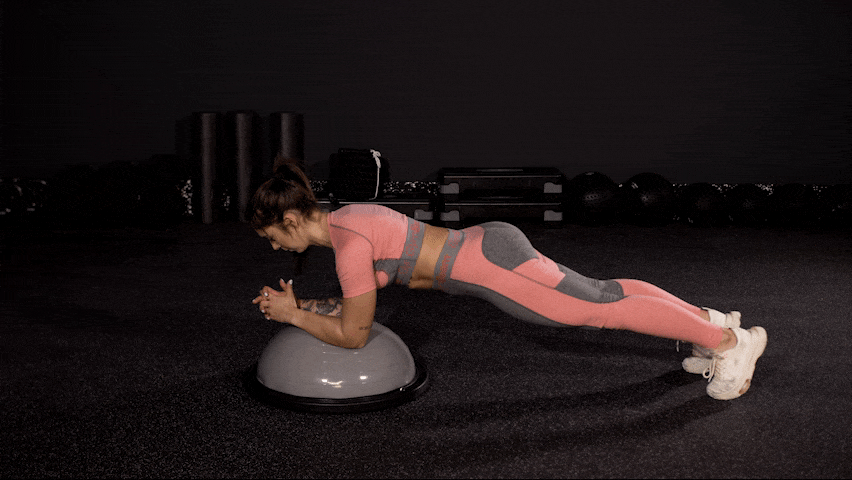
2. Bird Dog
- Starting position: Kneel on the balance pad and lean on it with outstretched arms. Keep your head in line with your spine and activate the core.
- Execution: With an exhale, raise and straighten your right arm and left leg at the same time. Inhale, return to the starting position. Then raise your left arm and right leg. Continue alternating sides until the entire set is complete.
- Common mistakes: Arching in the back, uncontrolled movement.

3. Lateral Pulldown
- Starting position: Lie on your stomach in the centre of the balance pad. Keep your legs slightly bent and place your knees and toes on the ground. Keep the chest upright and your head in line with your spine. Raise your arms and tighten your core.
- Execution: With an exhale, activate your interscapular muscles, gradually bend the arms at the elbows and pull them towards the hips in a controlled manner. With an inhale, return to the starting position and follow up with another repetition.
- Common mistakes: Rounding of the upper back, uncontrolled movement.
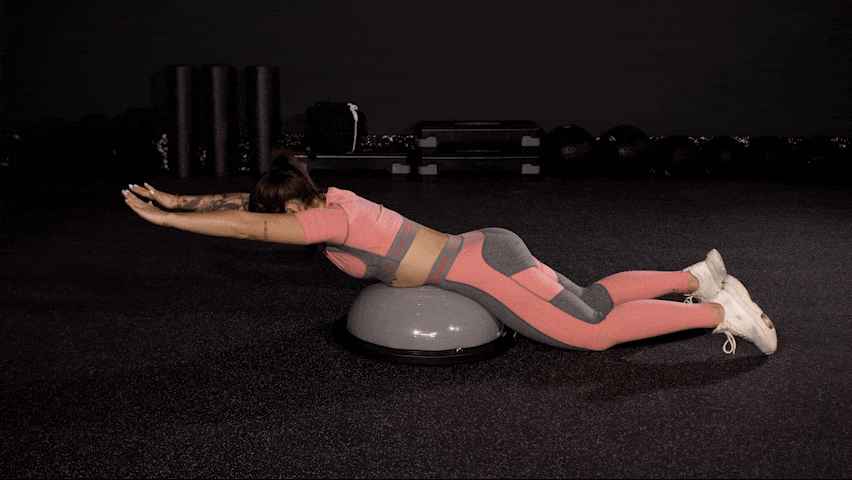
Further variants of this exercise
1. Banded Lateral Pulldown
You can add an extra challenge to this exercise by doing it with a resistance band or an expander. Grasp the expander with both hands, raise your arms, and then exercise in the same way as with the basic variant. Pull the expander under your head and try to keep it under constant tension.
4. Hyperextension
- Starting position: Lie on your stomach in the centre of the balance pad. Keep your legs slightly bent and place your knees and toes on the ground. Keep the chest upright and your head in line with your spine. Raise your arms and tighten your core.
- Execution: With an exhale, raise your arms, head and chest a few centimetres higher than the starting position, bending slightly backwards. Then, with an inbreath, return to the starting position and follow up with another repetition.
- Common mistakes: Uncontrolled movement.

Further variants of this exercise
1. Weighted Hyperextension
If you want to try a more challenging variant, grasp a single dumbbell or a lighter kettlebell with both hands. This variant is suitable for more advanced individuals, as you may risk overworking your lower back.
Discover our bestsellers:
5. Superman
- Starting position: Lie on your stomach in the centre of the balance pad. Keep your chest upright, and your head in line with your spine. Raise your arms. Then activate the core and lift your legs in a straight line.
- Execution: Breathe normally, keep your body tight and try to maintain this position for at least 15 seconds. Then relax, place your arms and legs on the floor, and follow up with another repetition.
- Common mistakes: Arching in the back, insufficient time holding the position.
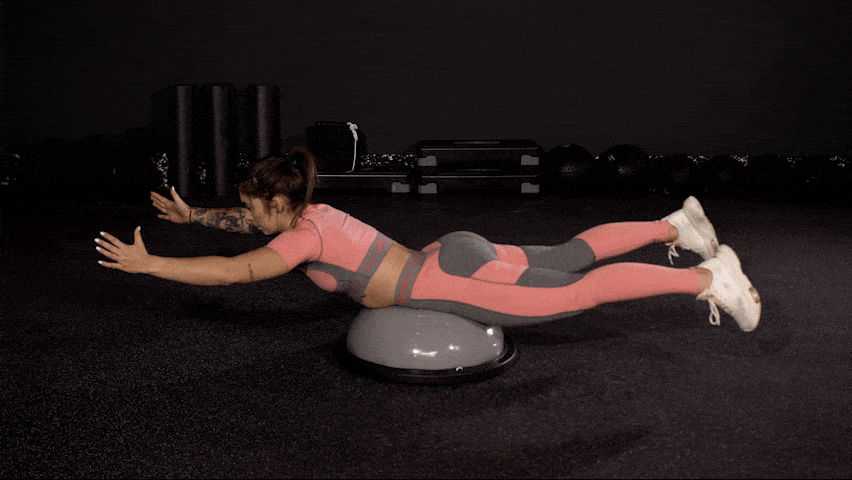
6. Mountain Climber
- Starting position: Turn the balance pad with the inflated ball part on the ground. Lean on the sides of the pad base with your arms outstretched and move into a plank position. Activate the core.
- Execution: With an exhalation, lift one leg and pull the knee across your body towards the chest. Then, exhale, return to the starting position and repeat with the other leg.
- Common mistakes: Arching in the back, uncontrolled movement.
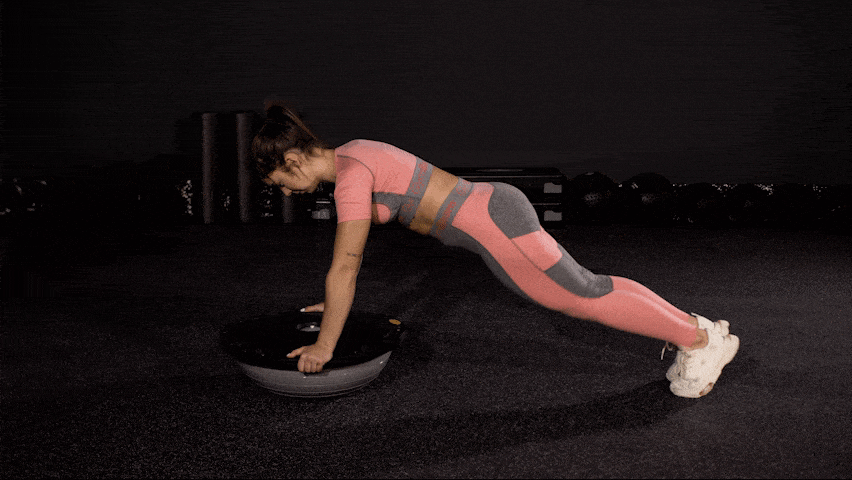
7. Push Ups
- Starting position: Turn the balance pad with the inflated ball part on the ground. Lean on the sides of the pad base with your arms outstretched and move into a plank position. Activate the core.
- Execution: Breathe in and do a push-up. In the bottom position, try to bring your chest towards the pad base. Make sure your back doesn’t arch.
- Common mistakes: Arching in the back, uncontrolled movement.
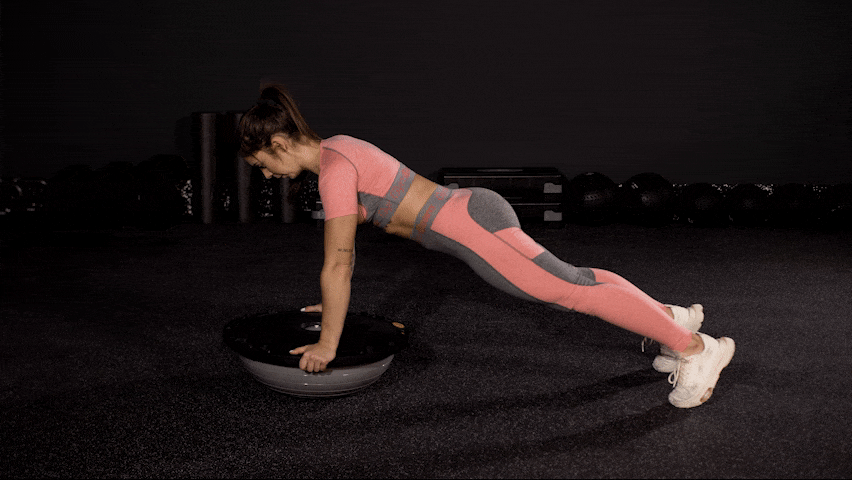
An easier variant: Knee Push Ups
If regular push-ups are too challenging for you, try the easier variation on the knees. When doing this, pay extra attention to avoid arching in the back, and make sure you perform the movement with maximum control.
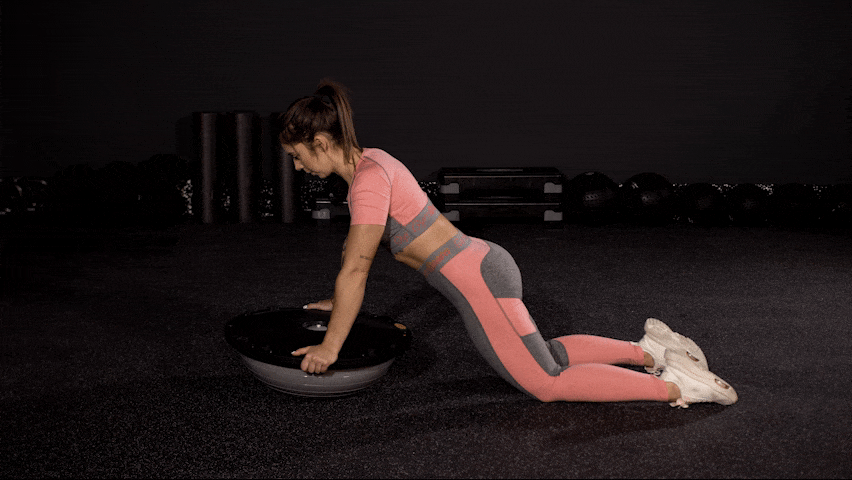
8. One Leg Standing
- Starting position: Carefully stand up on the balance pad. Let your arms hang alongside your body, straighten up and activate your core.
- Execution: With an exhale, lift one leg and try to bring the bent knee up toward the height of your hips. Feel free to start by simply lifting the leg only a few centimetres above the pad. Try to hold this position for at least 5 seconds, then put your leg back down and follow up with another repetition. Practice the entire series on one leg first, then on the other.
- Common mistakes: Uncontrolled movement.
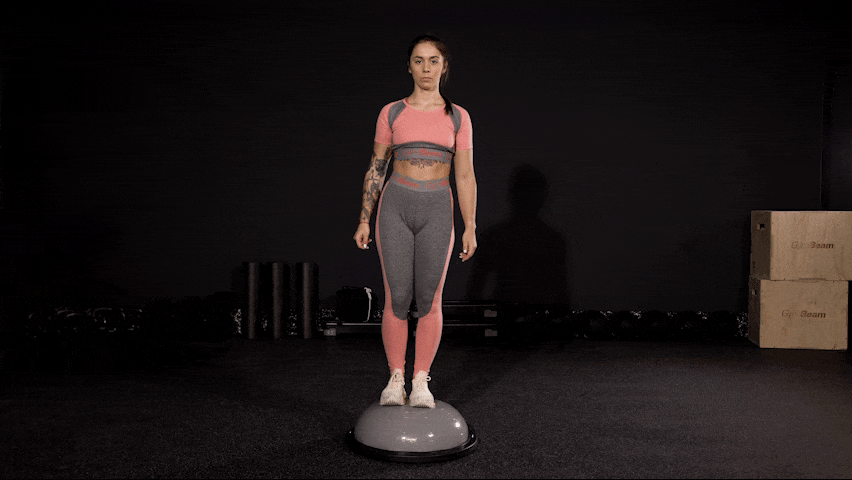
Further variants of this exercise
1. Weighted One Leg Standing
If you find this exercise too easy and require further challenge, try adding some extra weight. This can be done by making use of a dumbbell, a kettlebell or a weight plate, held in both hands in front of your chest. A weight can also be held in each hand by your sides.
9. Squat
- Starting position: Carefully stand up on the balance pad. Let your arms hang alongside your body, straighten up and activate your core.
- Execution: Inhale and move your pelvis back and down into a squat. Choose its depth so that you manage to preserve the natural curvature of your spine. Also pay attention to the knees, which should point slightly to the sides. Exhale and return to the starting position and follow up with another repetition.
- Common mistakes: Arching in the back, uncontrolled movement, insufficient range of motion, turning the knees inwards.
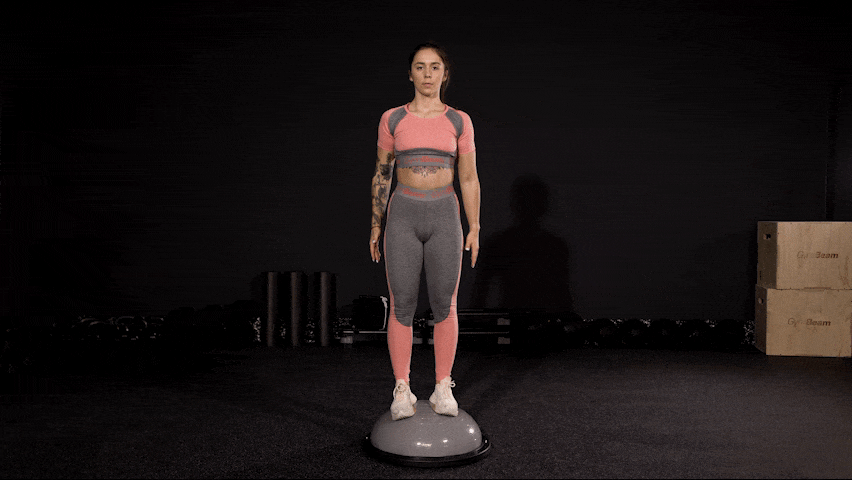
Further variants of this exercise
1. Goblet Squat
You can make this exercise more challenging by using a dumbbell or a kettlebell. Hold it out with both hands in front of your chest, and exercise the same way as in the basic bodyweight variation.
10. Back Lunge
- Starting position: Carefully stand up on the balance pad. Place your arms on your sides, straighten up and activate your core.
- Execution: Inhale and shift your weight to one leg. With the other leg take a step behind the pad and at the same time bend the knees of both legs. The knee of the leg that steps back may touch the floor. Exhale and return to the starting position. Then repeat alternating the legs. You may also first do the whole series with just one leg and then alternate afterwards.
- Common mistakes: Uncontrolled movement, insufficient range of motion.
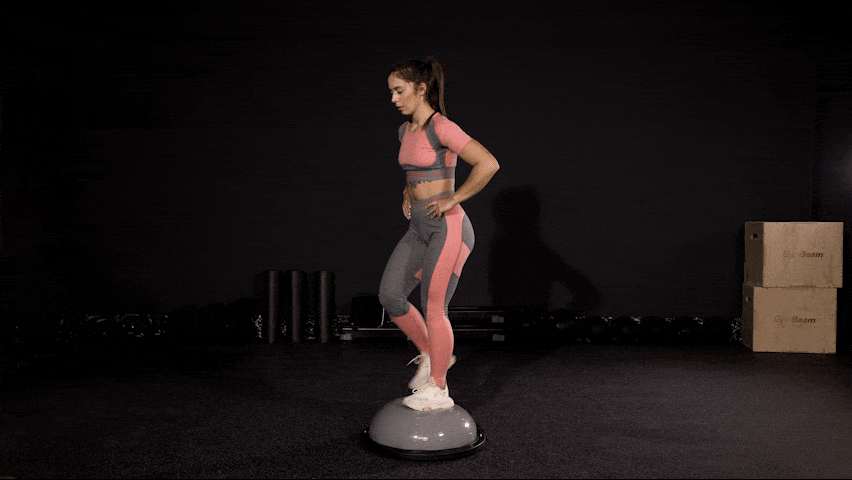
Further variants of this exercise
1. Weighted Lunges
Lunges can also be performed with some added weight. A kettlebell or dumbbell held out in front of your chest will do the trick, as will a powerbag or a barbell loaded with weight plates placed on your back. Alternatively, you can also wear a weighted vest.
What’s the bottom line?
Incorporating exercises using a balance half-ball can make for a great way to introduce some variety to your regular workout routine. It will help you strengthen your core, as well as your arms, back, glutes, and thighs. What’s more, you’ll improve your balance and coordination skills. A balance pad can be included in your weekly training plan in the form of a new HIIT or circuit training routine.
If you liked this article, share it with your friends, who’ll also enjoy these tips for working out with a balance pad.
[1] Physiopedia. Balance Training.– https://www.physio-pedia.com/Balance_Training
[2] Livescience.Com. Balance Exercise: Everything You Need to Know. – https://www.livescience.com/55321-balance-exercise.html
[3] Harvard Health. The real-world benefits of strengthening your core. – https://www.health.harvard.edu/healthbeat/the-real-world-benefits-of-strengthening-your-core
[4] Fakulta sportovních studií Masarykovy univerzity. Význam cvičení labilních ploch v kondičně-kompenzačním tréninku. – https://is.muni.cz/do/rect/el/estud/fsps/js13/balcvic/web/pages/03-vyznam-cviceni.html


Add a comment